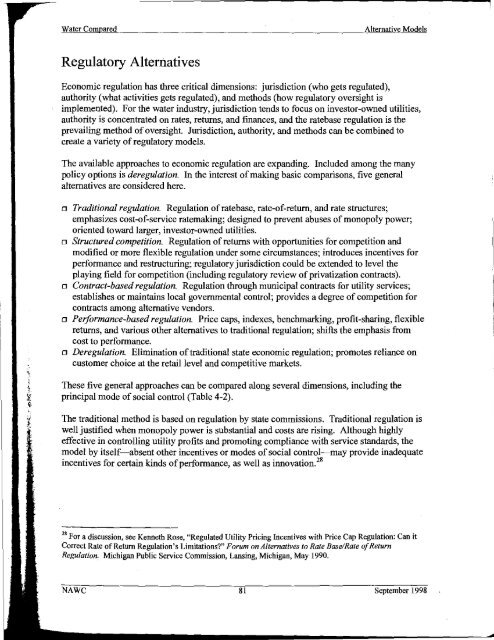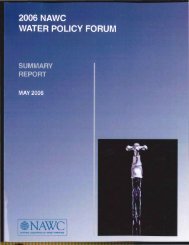BEECHER - NAWC
BEECHER - NAWC
BEECHER - NAWC
You also want an ePaper? Increase the reach of your titles
YUMPU automatically turns print PDFs into web optimized ePapers that Google loves.
Water ComparedAlternative ModelsRegulatory AlternativesEconomic regulation has three critical dimensions: jurisdiction (who gets regulated),authority (what activities gets regulated), and methods (how regulatory oversight isimplemented). For the water industry, jurisdiction tends to focus on investor-owned utilities,authority is concentrated on rates, returns, and finances, and the ratebase regulation is theprevailing method of oversight. Jurisdiction, authority, and methods can be combined tocreate a variety of regulatory models.The available approaches to economic regulation are expanding. Included among the manypolicy options is deregulation. In the interest of making basic comparisons, five generalalternatives are considered here.o Traditional regulation. Regulation ofratebase, rate-of-return, and rate structures;emphasizes cost -of-service ratemaking; designed to prevent abuses of monopoly power;oriented toward larger, investor-owned utilities.o Structured competition. Regulation of returns with opportunities for competition andmodified or more flexible regulation under some circumstances; introduces incentives forperformance and restructuring; regulatory jurisdiction could be extended to level theplaying field for competition (including regulatory review of privatization contracts).o Contract-based regulation. Regulation through municipal contracts for utility services;establishes or maintains local governmental control; provides a degree of competition forcontracts among alternative vendors.o Performance-based regulation. Price caps, indexes, benchmarking, profit-sharing, flexiblereturns, and various other alternatives to traditional regulation; shifts the emphasis fromcost to performance.o Deregulation. Elimination of traditional state economic regulation; promotes reliance oncustomer choice at the retail level and competitive markets.These five general approaches can be compared along several dimensions, including theprincipal mode of social control (Table 4-2).The traditional method is based on regulation by state commissions. Traditional regulation iswell justified when monopoly power is substantial and costs are rising. Although highlyeffective in controlling utility profits and promoting compliance with service standards, themodel by itself-absent other incentives or modes of social control-may provide inadequateincentives for certain kinds of performance, as well as innovation. 2828For a discussion, see Kenneth Rose, "Regulated Utility Pricing Incentives with Price Cap Regulation: Can itCorrect Rate of Return Regulation's Limitations?" Forum on Alternatives to Rate Base/Rate of ReturnRegulation Michigan Public Service Commission, Lansing, Michigan, May 1990.<strong>NAWC</strong> 81 September 1998
















